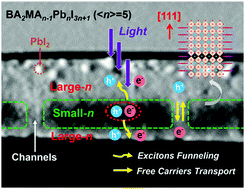(Scientists take a bite out of solar efficiency challenge with sandwich model)
2021-05-19 オーストラリア連邦・オーストラリア連邦研究会議(ARC)
・ ARC の励起科学(Exciton Science)分野のセンター・オブ・エクセレンス(CoE) 、オーストラリア連邦科学産業技術研究機構(CSIRO)および中華人民共和国・山東大学が、2D ペロブスカイト太陽電池(2D PSCs)を構成する準二次元ルドルスデン-ポッパー型ペロブスカイト(quasi-2D RPPs)薄膜のサンドイッチ構造を解明。
・ 2 枚の同一材料層の中間に異なる材料層を挟む同サンドイッチ構造は、太陽光の電気への変換において重要となる励起子を薄膜の中央層から両表面に移動させ、電極による効果的な電荷の収集を促してより効率的な発電を助ける。
・ 2D ペロブスカイト薄膜は、特定の構成要素が材料深部と表面付近に偏在する構造と考えられてきた。本研究では、その実際の構造と太陽電池での効果を特定した。
・ 2D PSCs は、3D PSCs に比べて安定性と耐久性に優れることから関心を集めている。CSIRO で作製したプロトタイプの 2D デバイスでは、13%の変換効率を実証。今後は、2D 薄膜の各層の厚みを調整することで変換効率の向上を図る。
・ 改良された 2D 薄膜のアプリケーションとして、太陽電池の他に光通信、バイオ医療イメージング、セキュリティや動作検出等の発光ダイオードや光検出器が考えられる。
・ 本研究の成果は、2D PSCs の作動原理の新たな基礎的理解を提供し、quasi-2D RPPs をベースとしたオプトエレクトロニックデバイスの設計と最適化に有益な影響を与えるもの。
URL: https://excitonscience.com/news/scientists-take-bite-out-solar-efficiency-challenge-sandwich-model
<NEDO海外技術情報より>
(関連情報)
Journal of Materials Chemistry C 掲載論文(アブストラクトのみ:全文は有料)
A sandwich-like structural model revealed for quasi-2D perovskite films
URL: https://pubs.rsc.org/en/content/articlelanding/2021/TC/D1TC00606A#!divAbstract
Abstract
The excellent performance and stability of perovskite solar cells (PSCs) based on quasi-2D Ruddlesden–Popper perovskites (RPPs) holds promise for their commercialization. Further improvement in the performance of 2D PSCs requires a detailed understanding of the microstructure of the quasi-2D perovskite films. Based on scanning transmission electron microscopy (STEM), time-resolved photoluminescence, and transient absorption measurements, a new sandwich-like structural model is proposed to describe the phase distribution of RPPs. In contrast to the conventional gradient distribution, it is found that small-n RPPs are sandwiched between large-n RPP phase layers at the front and back sides owing to crystallization initiated from both interfaces during film formation. This sandwich-like distribution profile facilitates excitons funneling from the film interior to both surfaces for dissociation while free carriers transport via large-n channels that permeate the film to ensure efficient charge collection by the corresponding electrodes, which is favorable for high-performance photovoltaics. This discovery provides a new fundamental understanding of the operating principles of 2D PSCs and has valuable implications for the design and optimization strategies of optoelectronic devices based on quasi-2D RPPs films.




